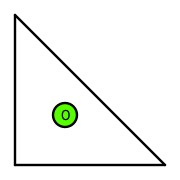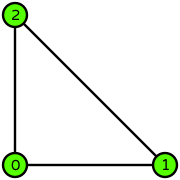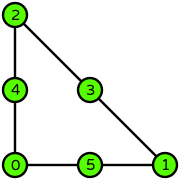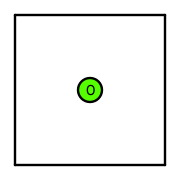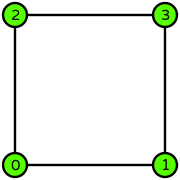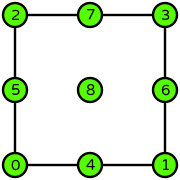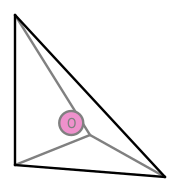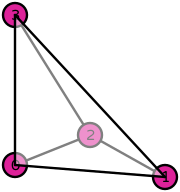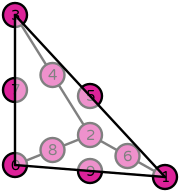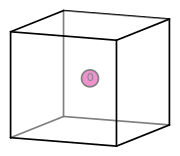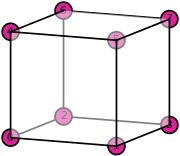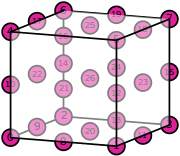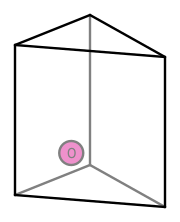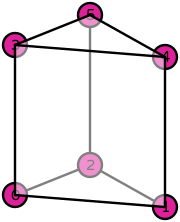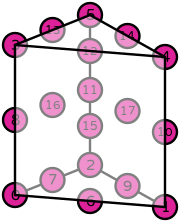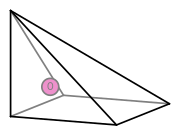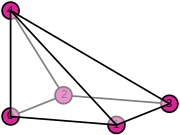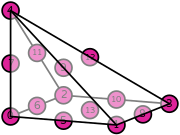| Basix | basix.ElementFamily.P
↓ Show Basix examples ↓↑ Hide Basix examples ↑Before running this example, you must install Basix: pip install fenics-basix This element can then be created with the following lines of Python: import basix
# Create discontinuous Lagrange (equispaced variant) degree 0 on a interval
element = basix.create_element(basix.ElementFamily.P, basix.CellType.interval, 0, lagrange_variant=basix.LagrangeVariant.equispaced, discontinuous=True)
# Create discontinuous Lagrange (equispaced variant) degree 1 on a interval
element = basix.create_element(basix.ElementFamily.P, basix.CellType.interval, 1, lagrange_variant=basix.LagrangeVariant.equispaced, discontinuous=True)
# Create discontinuous Lagrange (equispaced variant) degree 2 on a interval
element = basix.create_element(basix.ElementFamily.P, basix.CellType.interval, 2, lagrange_variant=basix.LagrangeVariant.equispaced, discontinuous=True)
# Create discontinuous Lagrange (equispaced variant) degree 0 on a triangle
element = basix.create_element(basix.ElementFamily.P, basix.CellType.triangle, 0, lagrange_variant=basix.LagrangeVariant.equispaced, discontinuous=True)
# Create discontinuous Lagrange (equispaced variant) degree 1 on a triangle
element = basix.create_element(basix.ElementFamily.P, basix.CellType.triangle, 1, lagrange_variant=basix.LagrangeVariant.equispaced, discontinuous=True)
# Create discontinuous Lagrange (equispaced variant) degree 2 on a triangle
element = basix.create_element(basix.ElementFamily.P, basix.CellType.triangle, 2, lagrange_variant=basix.LagrangeVariant.equispaced, discontinuous=True)
# Create discontinuous Lagrange (equispaced variant) degree 0 on a quadrilateral
element = basix.create_element(basix.ElementFamily.P, basix.CellType.quadrilateral, 0, lagrange_variant=basix.LagrangeVariant.equispaced, discontinuous=True)
# Create discontinuous Lagrange (equispaced variant) degree 1 on a quadrilateral
element = basix.create_element(basix.ElementFamily.P, basix.CellType.quadrilateral, 1, lagrange_variant=basix.LagrangeVariant.equispaced, discontinuous=True)
# Create discontinuous Lagrange (equispaced variant) degree 2 on a quadrilateral
element = basix.create_element(basix.ElementFamily.P, basix.CellType.quadrilateral, 2, lagrange_variant=basix.LagrangeVariant.equispaced, discontinuous=True)
# Create discontinuous Lagrange (equispaced variant) degree 0 on a tetrahedron
element = basix.create_element(basix.ElementFamily.P, basix.CellType.tetrahedron, 0, lagrange_variant=basix.LagrangeVariant.equispaced, discontinuous=True)
# Create discontinuous Lagrange (equispaced variant) degree 1 on a tetrahedron
element = basix.create_element(basix.ElementFamily.P, basix.CellType.tetrahedron, 1, lagrange_variant=basix.LagrangeVariant.equispaced, discontinuous=True)
# Create discontinuous Lagrange (equispaced variant) degree 2 on a tetrahedron
element = basix.create_element(basix.ElementFamily.P, basix.CellType.tetrahedron, 2, lagrange_variant=basix.LagrangeVariant.equispaced, discontinuous=True)
# Create discontinuous Lagrange (equispaced variant) degree 0 on a hexahedron
element = basix.create_element(basix.ElementFamily.P, basix.CellType.hexahedron, 0, lagrange_variant=basix.LagrangeVariant.equispaced, discontinuous=True)
# Create discontinuous Lagrange (equispaced variant) degree 1 on a hexahedron
element = basix.create_element(basix.ElementFamily.P, basix.CellType.hexahedron, 1, lagrange_variant=basix.LagrangeVariant.equispaced, discontinuous=True)
# Create discontinuous Lagrange (equispaced variant) degree 2 on a hexahedron
element = basix.create_element(basix.ElementFamily.P, basix.CellType.hexahedron, 2, lagrange_variant=basix.LagrangeVariant.equispaced, discontinuous=True)
# Create discontinuous Lagrange (equispaced variant) degree 0 on a prism
element = basix.create_element(basix.ElementFamily.P, basix.CellType.prism, 0, lagrange_variant=basix.LagrangeVariant.equispaced, discontinuous=True)
# Create discontinuous Lagrange (equispaced variant) degree 1 on a prism
element = basix.create_element(basix.ElementFamily.P, basix.CellType.prism, 1, lagrange_variant=basix.LagrangeVariant.equispaced, discontinuous=True)
# Create discontinuous Lagrange (equispaced variant) degree 2 on a prism
element = basix.create_element(basix.ElementFamily.P, basix.CellType.prism, 2, lagrange_variant=basix.LagrangeVariant.equispaced, discontinuous=True) Correct: interval,0,equispaced; interval,1,equispaced; interval,2,equispaced; triangle,0,equispaced; triangle,1,equispaced; triangle,2,equispaced; quadrilateral,0,equispaced; quadrilateral,1,equispaced; quadrilateral,2,equispaced; tetrahedron,0,equispaced; tetrahedron,1,equispaced; tetrahedron,2,equispaced; hexahedron,0,equispaced; hexahedron,1,equispaced; hexahedron,2,equispaced; prism,0,equispaced; prism,1,equispaced; prism,2,equispaced Not implemented: pyramid,0,equispaced; pyramid,1,equispaced; pyramid,2,equispaced |
| Basix.UFL | basix.ElementFamily.P
↓ Show Basix.UFL examples ↓↑ Hide Basix.UFL examples ↑Before running this example, you must install Basix.UFL: pip install fenics-ufl
pip install fenics-basix This element can then be created with the following lines of Python: import basix
import basix.ufl
# Create discontinuous Lagrange (equispaced variant) degree 0 on a interval
element = basix.ufl.element(basix.ElementFamily.P, basix.CellType.interval, 0, lagrange_variant=basix.LagrangeVariant.equispaced, discontinuous=True)
# Create discontinuous Lagrange (equispaced variant) degree 1 on a interval
element = basix.ufl.element(basix.ElementFamily.P, basix.CellType.interval, 1, lagrange_variant=basix.LagrangeVariant.equispaced, discontinuous=True)
# Create discontinuous Lagrange (equispaced variant) degree 2 on a interval
element = basix.ufl.element(basix.ElementFamily.P, basix.CellType.interval, 2, lagrange_variant=basix.LagrangeVariant.equispaced, discontinuous=True)
# Create discontinuous Lagrange (equispaced variant) degree 0 on a triangle
element = basix.ufl.element(basix.ElementFamily.P, basix.CellType.triangle, 0, lagrange_variant=basix.LagrangeVariant.equispaced, discontinuous=True)
# Create discontinuous Lagrange (equispaced variant) degree 1 on a triangle
element = basix.ufl.element(basix.ElementFamily.P, basix.CellType.triangle, 1, lagrange_variant=basix.LagrangeVariant.equispaced, discontinuous=True)
# Create discontinuous Lagrange (equispaced variant) degree 2 on a triangle
element = basix.ufl.element(basix.ElementFamily.P, basix.CellType.triangle, 2, lagrange_variant=basix.LagrangeVariant.equispaced, discontinuous=True)
# Create discontinuous Lagrange (equispaced variant) degree 0 on a quadrilateral
element = basix.ufl.element(basix.ElementFamily.P, basix.CellType.quadrilateral, 0, lagrange_variant=basix.LagrangeVariant.equispaced, discontinuous=True)
# Create discontinuous Lagrange (equispaced variant) degree 1 on a quadrilateral
element = basix.ufl.element(basix.ElementFamily.P, basix.CellType.quadrilateral, 1, lagrange_variant=basix.LagrangeVariant.equispaced, discontinuous=True)
# Create discontinuous Lagrange (equispaced variant) degree 2 on a quadrilateral
element = basix.ufl.element(basix.ElementFamily.P, basix.CellType.quadrilateral, 2, lagrange_variant=basix.LagrangeVariant.equispaced, discontinuous=True)
# Create discontinuous Lagrange (equispaced variant) degree 0 on a tetrahedron
element = basix.ufl.element(basix.ElementFamily.P, basix.CellType.tetrahedron, 0, lagrange_variant=basix.LagrangeVariant.equispaced, discontinuous=True)
# Create discontinuous Lagrange (equispaced variant) degree 1 on a tetrahedron
element = basix.ufl.element(basix.ElementFamily.P, basix.CellType.tetrahedron, 1, lagrange_variant=basix.LagrangeVariant.equispaced, discontinuous=True)
# Create discontinuous Lagrange (equispaced variant) degree 2 on a tetrahedron
element = basix.ufl.element(basix.ElementFamily.P, basix.CellType.tetrahedron, 2, lagrange_variant=basix.LagrangeVariant.equispaced, discontinuous=True)
# Create discontinuous Lagrange (equispaced variant) degree 0 on a hexahedron
element = basix.ufl.element(basix.ElementFamily.P, basix.CellType.hexahedron, 0, lagrange_variant=basix.LagrangeVariant.equispaced, discontinuous=True)
# Create discontinuous Lagrange (equispaced variant) degree 1 on a hexahedron
element = basix.ufl.element(basix.ElementFamily.P, basix.CellType.hexahedron, 1, lagrange_variant=basix.LagrangeVariant.equispaced, discontinuous=True)
# Create discontinuous Lagrange (equispaced variant) degree 2 on a hexahedron
element = basix.ufl.element(basix.ElementFamily.P, basix.CellType.hexahedron, 2, lagrange_variant=basix.LagrangeVariant.equispaced, discontinuous=True)
# Create discontinuous Lagrange (equispaced variant) degree 0 on a prism
element = basix.ufl.element(basix.ElementFamily.P, basix.CellType.prism, 0, lagrange_variant=basix.LagrangeVariant.equispaced, discontinuous=True)
# Create discontinuous Lagrange (equispaced variant) degree 1 on a prism
element = basix.ufl.element(basix.ElementFamily.P, basix.CellType.prism, 1, lagrange_variant=basix.LagrangeVariant.equispaced, discontinuous=True)
# Create discontinuous Lagrange (equispaced variant) degree 2 on a prism
element = basix.ufl.element(basix.ElementFamily.P, basix.CellType.prism, 2, lagrange_variant=basix.LagrangeVariant.equispaced, discontinuous=True) Correct: interval,0,equispaced; interval,1,equispaced; interval,2,equispaced; triangle,0,equispaced; triangle,1,equispaced; triangle,2,equispaced; quadrilateral,0,equispaced; quadrilateral,1,equispaced; quadrilateral,2,equispaced; tetrahedron,0,equispaced; tetrahedron,1,equispaced; tetrahedron,2,equispaced; hexahedron,0,equispaced; hexahedron,1,equispaced; hexahedron,2,equispaced; prism,0,equispaced; prism,1,equispaced; prism,2,equispaced Not implemented: pyramid,0,equispaced; pyramid,1,equispaced; pyramid,2,equispaced |
| Bempp-cl | "DP"
↓ Show Bempp-cl examples ↓↑ Hide Bempp-cl examples ↑Before running this example, you must install Bempp-cl: pip install numba scipy meshio
pip install bempp-cl This element can then be created with the following lines of Python: import bempp_cl.api
grid = bempp_cl.api.shapes.regular_sphere(1)
# Create discontinuous Lagrange (equispaced variant) degree 0 on a triangle
element = bempp_cl.api.function_space(grid, "DP", 0)
# Create discontinuous Lagrange (equispaced variant) degree 1 on a triangle
element = bempp_cl.api.function_space(grid, "DP", 1) |
| FIAT | FIAT.DiscontinuousLagrange
↓ Show FIAT examples ↓↑ Hide FIAT examples ↑Before running this example, you must install FIAT: pip install firedrake-fiat This element can then be created with the following lines of Python: import FIAT
# Create discontinuous Lagrange (equispaced variant) degree 0 on a interval
element = FIAT.DiscontinuousLagrange(FIAT.ufc_cell("interval"), 0)
# Create discontinuous Lagrange (equispaced variant) degree 1 on a interval
element = FIAT.DiscontinuousLagrange(FIAT.ufc_cell("interval"), 1)
# Create discontinuous Lagrange (equispaced variant) degree 2 on a interval
element = FIAT.DiscontinuousLagrange(FIAT.ufc_cell("interval"), 2)
# Create discontinuous Lagrange (equispaced variant) degree 0 on a triangle
element = FIAT.DiscontinuousLagrange(FIAT.ufc_cell("triangle"), 0)
# Create discontinuous Lagrange (equispaced variant) degree 1 on a triangle
element = FIAT.DiscontinuousLagrange(FIAT.ufc_cell("triangle"), 1)
# Create discontinuous Lagrange (equispaced variant) degree 2 on a triangle
element = FIAT.DiscontinuousLagrange(FIAT.ufc_cell("triangle"), 2)
# Create discontinuous Lagrange (equispaced variant) degree 0 on a tetrahedron
element = FIAT.DiscontinuousLagrange(FIAT.ufc_cell("tetrahedron"), 0)
# Create discontinuous Lagrange (equispaced variant) degree 1 on a tetrahedron
element = FIAT.DiscontinuousLagrange(FIAT.ufc_cell("tetrahedron"), 1)
# Create discontinuous Lagrange (equispaced variant) degree 2 on a tetrahedron
element = FIAT.DiscontinuousLagrange(FIAT.ufc_cell("tetrahedron"), 2) Correct: interval,0,equispaced; interval,1,equispaced; interval,2,equispaced; triangle,0,equispaced; triangle,1,equispaced; triangle,2,equispaced; tetrahedron,0,equispaced; tetrahedron,1,equispaced; tetrahedron,2,equispaced Not implemented: quadrilateral,0,equispaced; quadrilateral,1,equispaced; quadrilateral,2,equispaced; hexahedron,0,equispaced; hexahedron,1,equispaced; hexahedron,2,equispaced; prism,0,equispaced; prism,1,equispaced; prism,2,equispaced; pyramid,0,equispaced; pyramid,1,equispaced; pyramid,2,equispaced |
| NDElement | Family.Lagrange, continuity=Continuity.Discontinuous
↓ Show NDElement examples ↓↑ Hide NDElement examples ↑Before running this example, you must install NDElement: pip install ndelement This element can then be created with the following lines of Python: from ndelement import ciarlet
from ndelement.reference_cell import ReferenceCellType
# Create discontinuous Lagrange (equispaced variant) degree 0 on a interval
family = ciarlet.create_family(ciarlet.Family.Lagrange, 0, continuity=ciarlet.Continuity.Discontinuous)
element = family.element(ReferenceCellType.Interval)
# Create discontinuous Lagrange (equispaced variant) degree 1 on a interval
family = ciarlet.create_family(ciarlet.Family.Lagrange, 1, continuity=ciarlet.Continuity.Discontinuous)
element = family.element(ReferenceCellType.Interval)
# Create discontinuous Lagrange (equispaced variant) degree 2 on a interval
family = ciarlet.create_family(ciarlet.Family.Lagrange, 2, continuity=ciarlet.Continuity.Discontinuous)
element = family.element(ReferenceCellType.Interval)
# Create discontinuous Lagrange (equispaced variant) degree 0 on a triangle
family = ciarlet.create_family(ciarlet.Family.Lagrange, 0, continuity=ciarlet.Continuity.Discontinuous)
element = family.element(ReferenceCellType.Triangle)
# Create discontinuous Lagrange (equispaced variant) degree 1 on a triangle
family = ciarlet.create_family(ciarlet.Family.Lagrange, 1, continuity=ciarlet.Continuity.Discontinuous)
element = family.element(ReferenceCellType.Triangle)
# Create discontinuous Lagrange (equispaced variant) degree 2 on a triangle
family = ciarlet.create_family(ciarlet.Family.Lagrange, 2, continuity=ciarlet.Continuity.Discontinuous)
element = family.element(ReferenceCellType.Triangle)
# Create discontinuous Lagrange (equispaced variant) degree 0 on a quadrilateral
family = ciarlet.create_family(ciarlet.Family.Lagrange, 0, continuity=ciarlet.Continuity.Discontinuous)
element = family.element(ReferenceCellType.Quadrilateral)
# Create discontinuous Lagrange (equispaced variant) degree 1 on a quadrilateral
family = ciarlet.create_family(ciarlet.Family.Lagrange, 1, continuity=ciarlet.Continuity.Discontinuous)
element = family.element(ReferenceCellType.Quadrilateral)
# Create discontinuous Lagrange (equispaced variant) degree 2 on a quadrilateral
family = ciarlet.create_family(ciarlet.Family.Lagrange, 2, continuity=ciarlet.Continuity.Discontinuous)
element = family.element(ReferenceCellType.Quadrilateral)
# Create discontinuous Lagrange (equispaced variant) degree 0 on a tetrahedron
family = ciarlet.create_family(ciarlet.Family.Lagrange, 0, continuity=ciarlet.Continuity.Discontinuous)
element = family.element(ReferenceCellType.Tetrahedron)
# Create discontinuous Lagrange (equispaced variant) degree 1 on a tetrahedron
family = ciarlet.create_family(ciarlet.Family.Lagrange, 1, continuity=ciarlet.Continuity.Discontinuous)
element = family.element(ReferenceCellType.Tetrahedron)
# Create discontinuous Lagrange (equispaced variant) degree 2 on a tetrahedron
family = ciarlet.create_family(ciarlet.Family.Lagrange, 2, continuity=ciarlet.Continuity.Discontinuous)
element = family.element(ReferenceCellType.Tetrahedron)
# Create discontinuous Lagrange (equispaced variant) degree 0 on a hexahedron
family = ciarlet.create_family(ciarlet.Family.Lagrange, 0, continuity=ciarlet.Continuity.Discontinuous)
element = family.element(ReferenceCellType.Hexahedron)
# Create discontinuous Lagrange (equispaced variant) degree 1 on a hexahedron
family = ciarlet.create_family(ciarlet.Family.Lagrange, 1, continuity=ciarlet.Continuity.Discontinuous)
element = family.element(ReferenceCellType.Hexahedron)
# Create discontinuous Lagrange (equispaced variant) degree 2 on a hexahedron
family = ciarlet.create_family(ciarlet.Family.Lagrange, 2, continuity=ciarlet.Continuity.Discontinuous)
element = family.element(ReferenceCellType.Hexahedron) Correct: interval,0,equispaced; interval,1,equispaced; interval,2,equispaced; triangle,0,equispaced; triangle,1,equispaced; triangle,2,equispaced; quadrilateral,0,equispaced; quadrilateral,1,equispaced; quadrilateral,2,equispaced; tetrahedron,0,equispaced; tetrahedron,1,equispaced; tetrahedron,2,equispaced; hexahedron,0,equispaced; hexahedron,1,equispaced; hexahedron,2,equispaced Not implemented: prism,0,equispaced; prism,1,equispaced; prism,2,equispaced; pyramid,0,equispaced; pyramid,1,equispaced; pyramid,2,equispaced |
| Symfem | "discontinuous Lagrange" (equispaced)
"discontinuous Lagrange", variant="gll" (interval, GLL)
"discontinuous Q", variant="gll" (quadrilateral, GLL; hexahedron, GLL)
"discontinuous Lagrange", variant="gl" (interval, GL)
"discontinuous Q", variant="gl" (quadrilateral, GL; hexahedron, GL)
"discontinuous Lagrange", variant="legendre" (Legendre)
↓ Show Symfem examples ↓↑ Hide Symfem examples ↑Before running this example, you must install Symfem: pip install symfem This element can then be created with the following lines of Python: import symfem
# Create discontinuous Lagrange (equispaced variant) degree 0 on a interval
element = symfem.create_element("interval", "discontinuous Lagrange", 0)
# Create discontinuous Lagrange (equispaced variant) degree 1 on a interval
element = symfem.create_element("interval", "discontinuous Lagrange", 1)
# Create discontinuous Lagrange (equispaced variant) degree 2 on a interval
element = symfem.create_element("interval", "discontinuous Lagrange", 2)
# Create discontinuous Lagrange (equispaced variant) degree 0 on a triangle
element = symfem.create_element("triangle", "discontinuous Lagrange", 0)
# Create discontinuous Lagrange (equispaced variant) degree 1 on a triangle
element = symfem.create_element("triangle", "discontinuous Lagrange", 1)
# Create discontinuous Lagrange (equispaced variant) degree 2 on a triangle
element = symfem.create_element("triangle", "discontinuous Lagrange", 2)
# Create discontinuous Lagrange (equispaced variant) degree 0 on a quadrilateral
element = symfem.create_element("quadrilateral", "discontinuous Lagrange", 0)
# Create discontinuous Lagrange (equispaced variant) degree 1 on a quadrilateral
element = symfem.create_element("quadrilateral", "discontinuous Lagrange", 1)
# Create discontinuous Lagrange (equispaced variant) degree 2 on a quadrilateral
element = symfem.create_element("quadrilateral", "discontinuous Lagrange", 2)
# Create discontinuous Lagrange (equispaced variant) degree 0 on a tetrahedron
element = symfem.create_element("tetrahedron", "discontinuous Lagrange", 0)
# Create discontinuous Lagrange (equispaced variant) degree 1 on a tetrahedron
element = symfem.create_element("tetrahedron", "discontinuous Lagrange", 1)
# Create discontinuous Lagrange (equispaced variant) degree 2 on a tetrahedron
element = symfem.create_element("tetrahedron", "discontinuous Lagrange", 2)
# Create discontinuous Lagrange (equispaced variant) degree 0 on a hexahedron
element = symfem.create_element("hexahedron", "discontinuous Lagrange", 0)
# Create discontinuous Lagrange (equispaced variant) degree 1 on a hexahedron
element = symfem.create_element("hexahedron", "discontinuous Lagrange", 1)
# Create discontinuous Lagrange (equispaced variant) degree 2 on a hexahedron
element = symfem.create_element("hexahedron", "discontinuous Lagrange", 2)
# Create discontinuous Lagrange (equispaced variant) degree 0 on a prism
element = symfem.create_element("prism", "discontinuous Lagrange", 0)
# Create discontinuous Lagrange (equispaced variant) degree 1 on a prism
element = symfem.create_element("prism", "discontinuous Lagrange", 1)
# Create discontinuous Lagrange (equispaced variant) degree 2 on a prism
element = symfem.create_element("prism", "discontinuous Lagrange", 2)
# Create discontinuous Lagrange (equispaced variant) degree 0 on a pyramid
element = symfem.create_element("pyramid", "discontinuous Lagrange", 0)
# Create discontinuous Lagrange (equispaced variant) degree 1 on a pyramid
element = symfem.create_element("pyramid", "discontinuous Lagrange", 1)
# Create discontinuous Lagrange (equispaced variant) degree 2 on a pyramid
element = symfem.create_element("pyramid", "discontinuous Lagrange", 2) |



